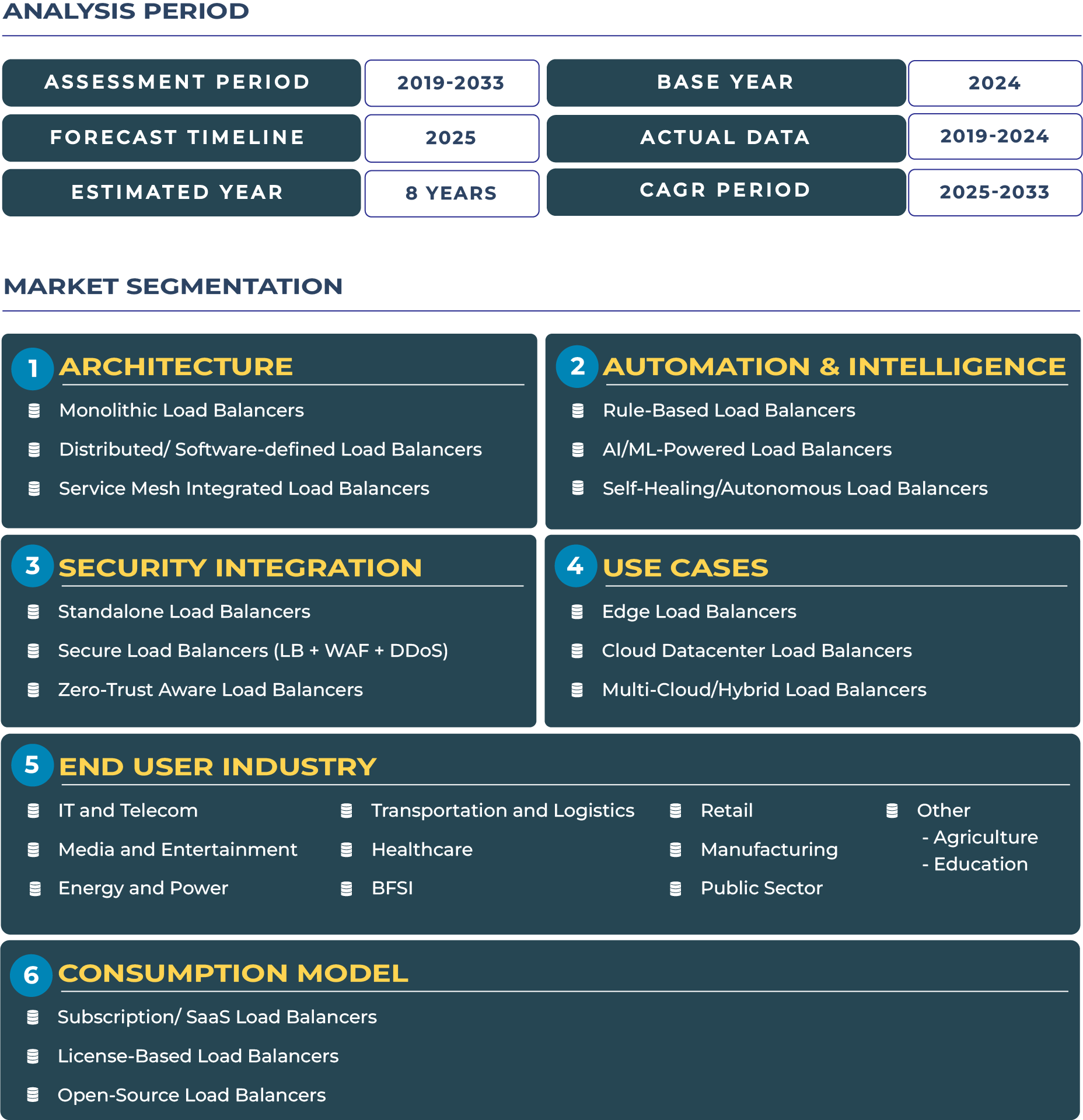Report Format:
![]()
![]() |
Pages: 110+
|
Pages: 110+
Peru Cloud Load Balancers Market Outlook: Resource-Driven Digital Catch-Up
Peru is entering a new phase of digital transformation where the cloud load balancers market plays a central role in bridging performance gaps across enterprises. Historically a resource-driven economy, Peru is now aligning with global digital trends as government-led modernization and SME-led adoption fuel the country’s cloud ecosystem. According to DataCube Research, the market is expected to grow from USD 15.7 million in 2025 to USD 64.0 million by 2033, expanding at a remarkable CAGR of 19.2%. The surge is attributed to a rise in fintech demand, increased focus on e-commerce reliability, and stronger telecom backbone networks. Initiatives such as Peru’s Presidency of the Council of Ministers digital agenda are accelerating cloud readiness, ensuring that SMEs and government bodies benefit from reliable traffic management and scalability. This transformation underscores Peru’s positioning as a fast-rising player in Latin America’s cloud load balancers industry.
Key Drivers and Barriers in Peru Cloud Load Balancers Industry
The Peru cloud load balancers ecosystem is being shaped by several strong growth drivers. The rise of fintech platforms, particularly in Lima, is intensifying demand for secure, low-latency application performance. Government-backed digitalization initiatives, including e-government services and cloud-based public portals, are further driving adoption of load balancing technologies. Additionally, the retail and e-commerce sector is expanding, with Peruvian consumers increasingly shifting to online platforms that rely on distributed load balancers to handle high-volume transactions and ensure uninterrupted services. Meanwhile, investments in backbone telecom networks by providers such as OSIPTEL are improving connectivity, creating a more favorable environment for cloud adoption.
However, the cloud load balancers sector in Peru also faces challenges. Outside Lima, IT skill gaps remain a pressing issue, limiting advanced adoption in secondary cities. Procurement complexity in government contracts slows down deployments, while Peru’s relatively small market size compared to regional leaders like Brazil or Mexico makes vendor entry cautious. Telecom infrastructure, while improving, continues to experience bottlenecks in remote regions, limiting nationwide scalability. These barriers underline the need for localized service delivery models and targeted training programs to strengthen adoption across all market segments.
Emerging Trends and Strategic Opportunities in Peru Cloud Load Balancers Market
The cloud load balancers landscape in Peru is evolving with several notable trends. Telco-cloud collaborations are on the rise, enabling telecom operators to integrate load balancing into bundled connectivity and cloud offerings. This is particularly attractive to SMEs, who often lack in-house IT resources but require scalable solutions to handle growing online traffic. SaaS adoption by SMEs in sectors such as logistics, retail, and healthcare is another significant trend, further boosting the demand for cost-efficient, software-defined load balancers. Additionally, hybrid IT adoption by banks in Lima and Arequipa is creating opportunities for service mesh integrated load balancers, allowing institutions to balance workloads across private and public cloud environments while maintaining regulatory compliance.
Opportunities are also emerging in niche segments. Telcos are well-positioned to co-sell SMB-focused load balancer packages, extending their reach beyond metropolitan areas. Government tenders for digital infrastructure upgrades present another critical opportunity, as the state actively seeks to modernize digital service delivery. Furthermore, fintech and e-commerce startups are showing interest in managed load balancing as a service, reducing their operational overhead while ensuring secure and resilient application performance. These opportunities position Peru’s cloud load balancers industry as a strategic growth hub within Latin America.
Competitive Landscape: Telcos and Global Vendors Driving Market Direction
The Peru cloud load balancers sector is marked by collaboration between local telcos and international vendors. Global players such as F5 Networks are present in the market, offering advanced distributed load balancing solutions suited for fintech and retail sectors. Meanwhile, local telecom operators are taking the lead in extending cloud adoption to SMEs and rural businesses through tailored go-to-market (GTM) strategies. Telco-led distribution models are particularly effective in extending reach beyond Lima, offering pre-packaged cloud and load balancing bundles for SMBs. Strategic collaborations between MSPs and telcos are also creating integrated offerings that combine connectivity, CDN, and managed load balancing services. This dual presence of global expertise and local delivery makes the competitive landscape dynamic, aligning Peru cloud load balancers market with global benchmarks while adapting to local realities.







